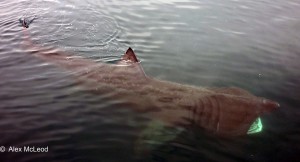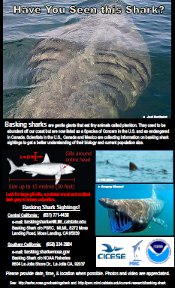By Dave Ebert
Pacific Shark Research Center

A Basking Shark (Cetorhinus maximus) tagged off the California coast in June 2011 has turned up northeast of the Hawaiian Islands. The shark, which was first spotted, and tagged with a pop-up satellite tag, traveled nearly 2500 miles over the past 8 months, making this the longest recorded movement of this shark species in the Pacific Ocean. In addition to the distance moved by this shark, data on the water temperature and the depth that the shark traveled was also recorded. This information will be important in determining habitat preference and utilization.
Despite their coastal occurrence in temperate seas, this large (up to 30 feet or more) charismatic species is poorly known. This is especially true in the Eastern North Pacific where no studies have been made on their abundance or population structure. The IUCN lists the Basking Shark as vulnerable globally, but in the Eastern North Pacific it is listed as endangered. In Canada it has been listed as endangered where its population has undergone significant historical declines. More recently (April 2010) the U.S. listed the Pacific coast Basking Shark population as a “Species of Concern”.
The Basking Shark is the second largest shark species in the world and has been reported globally from high latitude seas, including arctic waters, to the lower latitudes including the tropics. The distribution of these sharks changes seasonally with their abundance shifting from higher to lower latitudes in the autumn and winter months. As they move into warm temperate and tropical seas they exhibit subtropical submergence diving to cooler waters often several hundred meters below the surface. This explains why they are rarely, if ever, seen in the tropics.
Given the lack of knowledge of this species along the Pacific coast, a collaborative project was initiated in 2010 between the Pacific Shark Research Center (Moss Landing Marine Laboratories) and NOAA Fisheries Southwest Fisheries Science Center (La Jolla, CA) to investigate the abundance, distribution, and population status of Basking Sharks. This is part of a tri-national program with Canadian and Mexican colleagues. This multi-faceted project includes an educational and outreach component to raise public awareness, and broaden the base of “citizen scientist”. This latter facet of the project greatly benefits both the researchers and the public by asking communities to act as “citizen scientists” and report Basking Shark sightings. Researchers gain knowledge on the occurrence and movements of these sharks, which over time will allow migration patterns to surface, and the public gains knowledge and awareness about the ocean, its creatures, and its issues and threats.

From a population perspective the geographic range of the population, connectivity throughout the Pacific and population dynamics are currently unknown, but this new information indicating that these sharks may use large expanses of the Pacific Ocean as critical habitat will be important to assessing potential sources of mortality outside the United States, Canadian, and Mexican Economic Exclusive Zones as well as the relative impacts of human interactions and environmental effects on population trends. The information being gathered will begin to fill vital information gaps in order to develop a recovery plan that will maximize the potential to rebuild the Basking Shark population in the eastern North Pacific.
Contact Dr. David Ebert, Director, Pacific Shark Research Center, Moss Landing Marine Laboratories for more information:
E-mail: debert@mlml.calstate.edu Ph.: 831-771-4427

